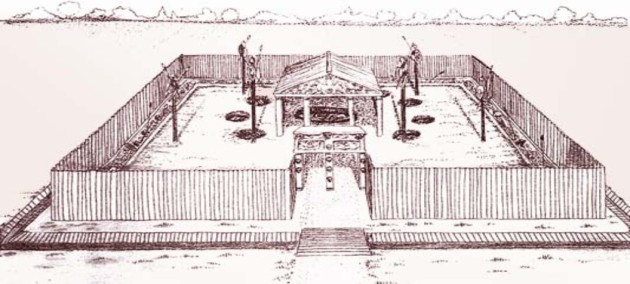The sanctuary of Gournay-sur-Aronde (Oise)
The sanctuary at Gournay-sur-Aronde has been fully excavated. It was situated on Bellovaci territory[1] and can be dated to the middle of the 3rd century BC. It presents several components.
 Informations[2]
Informations[2]This sanctuary includes first a sacred enclosure, that is a 250m2 area that men carefully carved out to make it the god's property. It is a rectangle with rounded off corners. The entrance on the eastern side opened on the rising sun at the summer solstice. The enclosure was realized by a wall made of wattle and daub as well as by two ditches one outside the wall and the other inside the enclosure. These installations had a symbolic value, marking the separation between the divine and secular worlds.
The access to the sanctuary had been conceived as an entrance lock whereby to pass from the secular world to the realm of the gods. A porch was erected as early as the 3rd century. It must have been a sizeable structure built on eight posts and breaching the two ditches. This porch may have included a second storey and housed weapons, chariot parts, human and bovine crania such as were found in the ditches. At the centre of the enclosure was a hollow altar, that is a pit dug 2 meters deep straight into the earth. Oval in shape, this 3x4m pit was the prime means of communication with the divinity and it may be surmised that it was used by the gods of the underworld. Very soon the altar got covered along with the ambulatory zone by a two sided roof.
The Gournay sanctuary has also imparted a precious documentation on the main rites practised therein. Concerning animal sacrifices thousands of animal bones have been unearthed. They always belonged to domesticated animals, the same as offered by the Romans and the Greeks, namely bovines, pigs and sheep. Gournay hosted two kinds of sacrifices. The first involved bovines. The animal was offered in its totality and its carcass was left in the pit where it remained for several months. The second sacrifice was the commensal sacrifice[3] at which only young pigs and lambs were sacrificed. They were intended for a sharing between men and gods. The former were allotted the top cuts, legs and shoulders while to the gods rose the smoke of the offal that had been grilled. The bones of the actually eaten prime cuts thrown in the internal ditch would indicate that these ritual meals took place inside the enclosure.
Such cult sites built as far back as the 3rd century BC, were still extent in the Roman era in the shape of stone built structures surrounded by a gallery.







